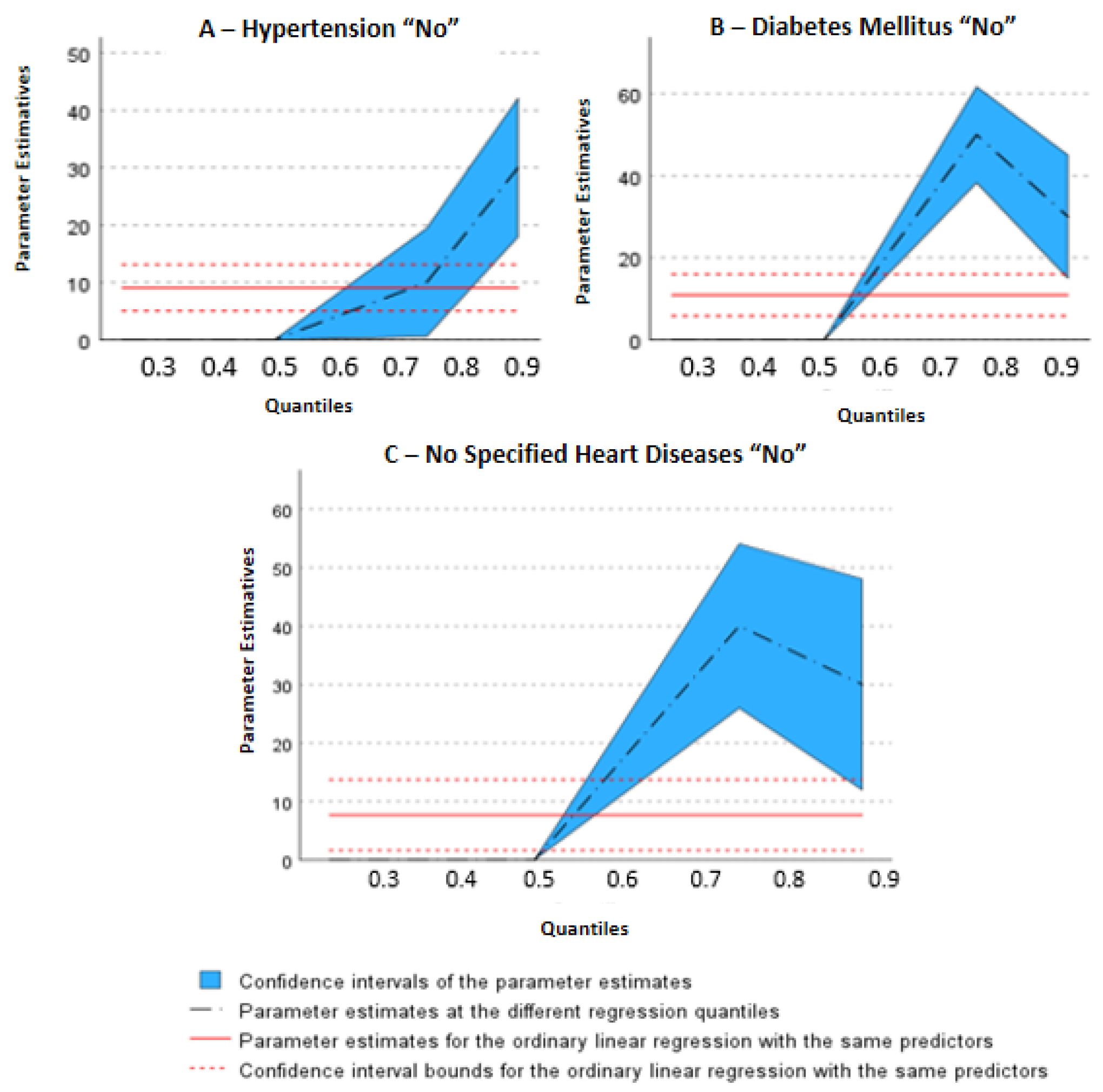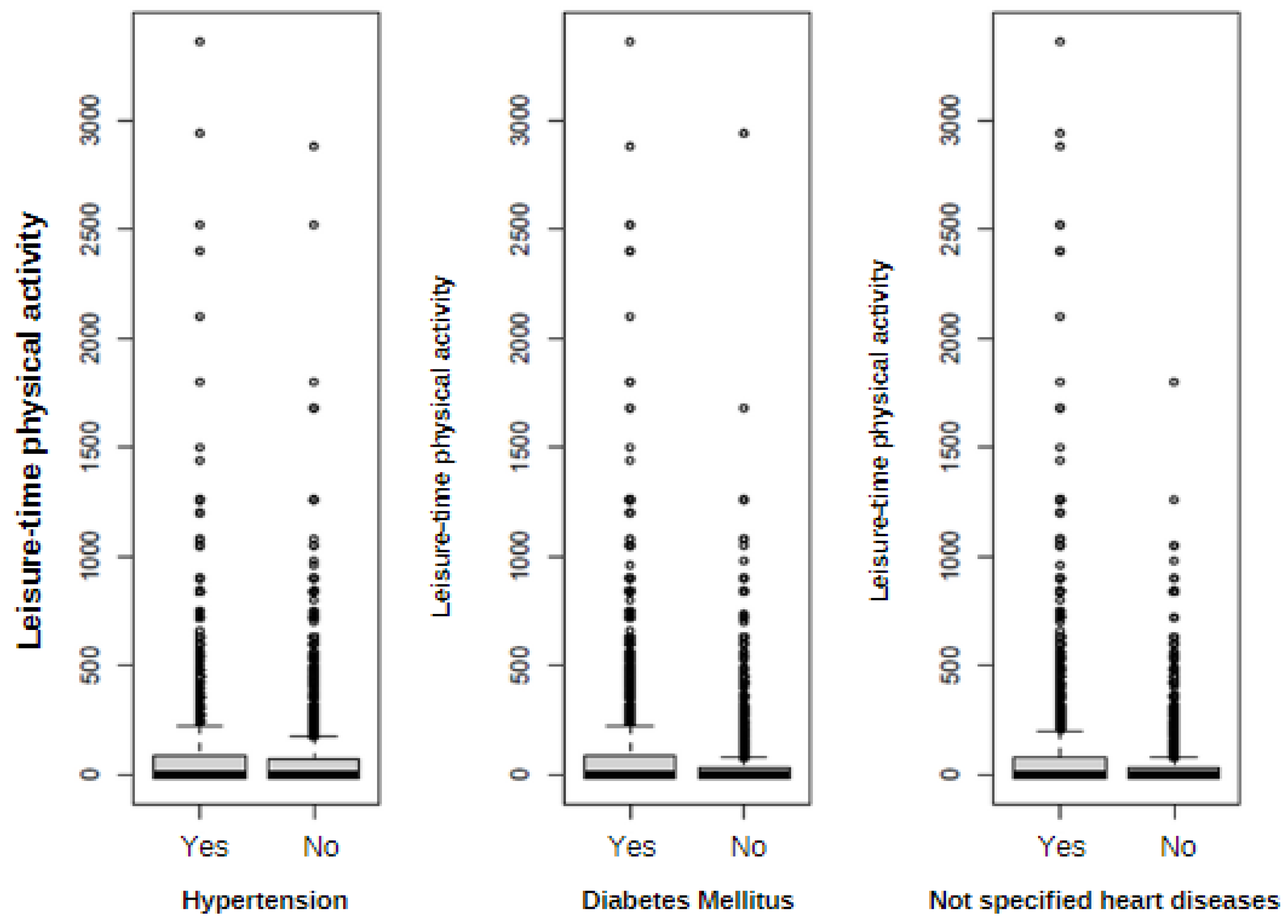Physical Activity Levels in Leisure Time, Sociodemographic Characteristics, and Chronic Non-Communicable Diseases in Brazilian Older Adults: National Health Survey, 2019
Abstract
:1. Introduction
2. Materials and Methods
3. Results
4. Discussion
5. Conclusions
Author Contributions
Funding
Institutional Review Board Statement
Informed Consent Statement
Data Availability Statement
Acknowledgments
Conflicts of Interest
References
- Bonifácio, G.; Guimarães, R. Projeções Populacionais por Idade e Sexo para o Brasil até 2100. Inst. Pesqui. Econ—IPEA. 2021; p. 65. Available online: https://www.ipea.gov.br/portal/images/stories/PDFs/TDs/td_2698.pdf (accessed on 25 March 2023).
- Ministério da Saúde, Secretaria de Vigilância em Saúde, Departamento de Análise em Saúde e Vigilância de Doenças Não Transmissíveis. Plano de Ações Estratégicas para o Enfrentamento das Doenças Crônicas e Agravos não Transmissíveis no Brasil 2021–2030. Brasília; 2021; Volume 1, p. 118. Available online: http://bvsms.saude.gov.br/bvs/publicacoes/plano_enfrentamento_doencas_cronicas_agravos_2021_2030.pdf (accessed on 25 March 2023).
- Moreira, L.B.; da Silva, S.L.A.; de Castro, A.E.F.; Lima, S.S.; Estevam, D.O.; de Freitas, F.A.S.; Vieira, É.L.M.; Pereira, D.S. Fatores associados a capacidade funcional de idosos adscritos à Estratégia de Saúde da Família. Cien Saude Colet. 2020, 25, 2041–2050. [Google Scholar] [CrossRef] [PubMed]
- Almeida AS de Fontes, P.A.; Reinaldo, J.M.; Neta, M.d.L.F.; dos Santos Silva, R.J.; Wichi, R.B. Influence of overweight on the functional capacity of physically active older women. Rev. Bras. Cineantropometria Desempenho Hum. 2020, 22, e67000. [Google Scholar] [CrossRef]
- De Camargo, E.M.; Añez, C.R.R. WHO Guidelines on Physical Activity and Sedentary Behavior. World Health Organization, 2020. Available online: https://www.who.int/publications/i/item/9789240014886 (accessed on 13 May 2023).
- Da Silva, A.G.; Teixeira, R.A.; Prates, E.J.S.; Malta, D.C. Monitoramento e projeções das metas de fatores de risco e proteção para o enfrentamento das doenças crônicas não transmissíveis nas capitais brasileiras. Cien Saude Colet. 2021, 26, 1193–1206. [Google Scholar] [CrossRef] [PubMed]
- Departamento de Análise em Saúde e Vigilância de Doenças Não Transmissíveis, Secretaria de Vigilância em Saúde—SVS. Cartilha—Vigitel Brasil 2019: Vigilância de Fatores de Risco e Proteção para Doenças Crônicas por Inquérito Telefônico. 1a edição. Vol. 6, Ministério da Saúde. Brasília; 2020; p. 139. Available online: http://bvsms.saude.gov.br/bvs/publicacoes/vigitel_brasil_2019_vigilancia_fatores_risco.pdf (accessed on 13 January 2023).
- Sumimoto, Y.; Yanagita, M.; Miyamatsu, N.; Okuda, N.; Nishi, N.; Nakamura, Y.; Nakamura, K.; Miyagawa, N.; Miyachi, M.; Kadota, A.; et al. Association between socioeconomic status and physical inactivity in a general Japanese population: NIPPON DATA 2010. PLoS ONE 2021, 16, e0254706. [Google Scholar] [CrossRef] [PubMed]
- Stopa, S.R.; Szwarcwald, C.L.; de Oliveira, M.M.; Gouvea, E.d.C.D.P.; Vieira, M.L.F.P.; de Freitas, M.P.S.; Sardinha, L.M.V.; Macário, E.M. Pesquisa Nacional de Saúde 2019: Histórico, métodos e perspectivas. Epidemiol. Serv. Saude 2020, 29, e2020315. [Google Scholar] [CrossRef] [PubMed]
- Instituto Brasileiro de Geografia e Estatistíca—IBGE. Pesquisa Nacional de Saúde 2019: Percepção do Estado de Saúde, Estilos de Vida, Doenças Crônicas e Saúde Bucal. 2019; p. 113. Available online: http://www.pns.icict.fiocruz.br/arquivos/Portaria.pdf (accessed on 1 September 2023).
- Ministério da Saúde Brasil. Estatuto do Idoso—3a edição. 2013; p. 70. Available online: www.saude.gov.br/editora (accessed on 24 February 2023).
- Lamarche, C. Quantile Regression Methods. In Handbook of Labor, Human Resources, and Population Economics; Zimmermann, K., Ed.; Springer: Cham, Switzerland, 2020; pp. 1–15. [Google Scholar]
- De Carvalho Melo, S.P.d.S.; de Carvalho Barreto, M.N.S.; de Souza, N.P.; de Melo Rodrigues, H.; de Lira, P.I.C.; Cesse, E.Â.P. Determinantes socioeconômicos das doenças crônicas não transmissíveis em um contexto de desigualdades no nordeste brasileiro. Res. Soc. Dev. 2022, 11, e12311628822. [Google Scholar] [CrossRef]
- Schenker, M.; da Costa, D.H. Advances and challenges of health care of the elderly population with chronic diseases in primary health care. Cienc. Saude Coletiva 2019, 24, 1369–1380. [Google Scholar] [CrossRef] [PubMed]
- Mendonça, G.; de Oliviera Mendes, J.; de Lucena, J.M.S.; de Farias Júnior, J.C. Os fatores sociodemográficos moderam a associação da prática de atividade física dos pais e amigos com o nível de atividade física dos adolescentes? Rev. Bras. Atividade Fís. Saúde 2020, 24, 1–9. [Google Scholar] [CrossRef]
- Christofoletti, M.; Streit, I.A.; Garcia, L.M.T.; Mendonça, G.; Benedetti, T.R.B.; Papini, C.B.; Borges, L.J.; Binotto, M.A.; e Silva-Júnior, F.L. Barreiras e facilitadores para a prática de atividade física em diferentes domínios no Brasil: Uma revisão sistemática. Cien Saude Colet. 2022, 27, 3487–3502. [Google Scholar] [CrossRef] [PubMed]
- De Oliveira, B.G.; Hohl, M.; Hino, A.A. Barreiras associadas à prática de atividade física no tempo livre de idosos com insuficiência cardíaca. Rev. Bras. Atividade Fís. Saúde 2019, 23, 1–7. [Google Scholar] [CrossRef]
- World Health Organization. World Health Statistics 2018; WHO: Geneva, Switzerland, 2018; pp. 1–26.
- Marmot, M.; Bell, R. Social determinants and non-communicable diseases: Time for integrated action. BMJ 2019, 364, l251. [Google Scholar] [CrossRef] [PubMed]
- Da Silva Sousa, N.F.; Lima, M.G.; Cesar, C.L.G.; de Azevedo Barros, M.B. Envelhecimento ativo: Prevalência e diferenças de gênero e idade em estudo de base populacional. Cad. Saude Publica 2018, 34, 1–16. [Google Scholar]
- Centro Internacional de Longevidade Brasil—ILC-Brasil. Envelhecimento Ativo: Um Marco Político em Resposta à Revolução da Longevidade, 1st ed.; Centro Internacional de Longevidade Brasil: Rio de Janeiro, Brazil, 2015. [Google Scholar]
- Da Silveira, M.B.G.; Barbosa, N.F.M.; Peixoto, A.P.B.; Xavier, É.F.M.; Xavier Júnior, S.F.A. Aplicação da regressão logística na análise dos dados dos fatores de risco associados à hipertensão arterial. Res. Soc. Dev. 2021, 10, e20101622964. [Google Scholar] [CrossRef]
- Simões, T.C.; Meira, K.C.; Dos Santos, J.; Câmara, D.C.P. Prevalências de doenças crônicas e acesso aos serviços de saúde no Brasil: Evidências de três inquéritos domiciliares. Cien. Saude Colet. 2021, 26, 3991–4006. [Google Scholar] [CrossRef] [PubMed]
- Ezeh, A.; Oyebode, O.; Satterthwaite, D.; Chen, Y.F.; Ndugwa, R.; Sartori, J.; Mberu, B.; Melendez-Torres, G.J.; Haregu, T.; Watson, S.I.; et al. The history, geography, and sociology of slums and the health problems of people who live in slums. Lancet 2017, 389, 547–558. [Google Scholar] [CrossRef] [PubMed]
- da Silva, P.S.C.; Boing, A.F. Fatores associados à prática de atividade física no lazer: Análise dos brasileiros com doenças crônicas. Cien. Saude Colet. 2021, 26, 5727–5738. [Google Scholar] [CrossRef] [PubMed]
- Doukky, R.; Mangla, A.; Ibrahim, Z.; Poulin, M.-F.; Avery, E.; Collado, F.M.; Kaplan, J.; Richardson, D.; Powell, L.H. Impact of Physical Inactivity on Mortality in Patients with Heart Failure. Physiol. Behav. 2017, 176, 1139–1148. [Google Scholar] [CrossRef] [PubMed]
- Collado-Mateo, D.; Lavín-Pérez, A.M.; Peñacoba, C.; Del Coso, J.; Leyton-Román, M.; Luque-Casado, A.; Gasque, P.; Fernández-del-Olmo, M.Á.; Amado-Alonso, D. Key factors associated with adherence to physical exercise in patients with chronic diseases and older adults: An umbrella review. Int. J. Environ. Res. Public Health 2021, 18, 2023. [Google Scholar] [CrossRef] [PubMed]
- Zilli, C.A.; Ribeiro, M.D.; Droubi, L.F.P.; Hochheim, N. Análise de Modelos de Regressão Quantílica Obtidos a Partir de Dados Imobiliários. XX Congr. Bras. Eng. Avaliações Perícias 2019. Available online: https://ibape-nacional.com.br/biblioteca/wp-content/uploads/2020/02/AO-06-An%C3%A1lise-de-Modelos-de-Regress%C3%A3o-Quant%C3%ADlica-Obtidos-a-Partir-de-Dados-Imobili%C3%A1rios.pdf (accessed on 1 September 2023).



| Variable Type | Question * | Variable | Variable Characteristic | Categorization |
|---|---|---|---|---|
| DEPENDENT | Sum of questions: P034 P035 P036 P03701 P03702 P03601 | Leisure-Time Physical Activity | Continuous Nominal—dichotomous WHO classification was adopted [5] | in Minutes/Week
|
| INDEPENDENT | C008 | Age Group | Nominal dichotomized (using ≥60 years as cutting bridge for the characterization of “elderly”; using the classification in “long-lived-elderly” for those aged 80 years or over). Possibility of greater autonomy [3] | The classification was adopted:
|
| C006 | Gender | Biological |
| |
| C009 | Race/ethnicity | Nominal—dichotomized (definition presented in the NHS document) |
| |
| D00901 | Education | Nominal—dichotomized (definition presented in the NHS document) |
| |
| V0026 | Housing | Nominal—dichotomized (definition presented in the NHS document) |
| |
| Q00201 | Hypertension | Nominal—dichotomized |
| |
| Q03001 | Diabetes Mellitus | Nominal—dichotomized |
| |
| Q06306 | Not specified heart diseases | Nominal—dichotomized |
|
| Sociodemographic Variables | n | % | % (CI 95%) | ||
|---|---|---|---|---|---|
| Lower Limit | Upper Limit | ||||
| Age Group | Older adults | 20,057 | 86.7 | 86.2 | 87.1 |
| Oldest-old adults | 3087 | 13.3 | 12.9 | 13.8 | |
| Gender | Male | 10,404 | 44.95 | 44.3 | 45.6 |
| Female | 12,740 | 55.04 | 54.4 | 55.7 | |
| Race/ethnicity | White | 10,071 | 43.51 | 42.9 | 44.2 |
| Non-white | 13,071 | 56.48 | 55.8 | 57.1 | |
| Education | Reads and writes | 17,689 | 76.43 | 75.9 | 77.0 |
| Cannot read or write | 5455 | 23.56 | 23.0 | 24.1 | |
| Housing | Urban | 17,673 | 76.36 | 75.8 | 76.9 |
| Rural | 5471 | 23.63 | 23.1 | 24.2 | |
| Variable | n | CI 95% | |||
|---|---|---|---|---|---|
| % | Lower Limit | Upper Limit | |||
| Hypertension | No | 10,142 | 45 | 44.3 | 45.6 |
| Yes | 12,428 | 55 | 54.4 | 55.7 | |
| Diabetes Mellitus | No | 17,722 | 80 | 79.9 | 81.0 |
| Yes | 4305 | 20 | 19.0 | 20.1 | |
| Not specified heart diseases | No | 20,004 | 88 | 87.6 | 88.4 |
| Yes | 2724 | 12 | 11.6 | 12.4 | |
Disclaimer/Publisher’s Note: The statements, opinions and data contained in all publications are solely those of the individual author(s) and contributor(s) and not of MDPI and/or the editor(s). MDPI and/or the editor(s) disclaim responsibility for any injury to people or property resulting from any ideas, methods, instructions or products referred to in the content. |
© 2023 by the authors. Licensee MDPI, Basel, Switzerland. This article is an open access article distributed under the terms and conditions of the Creative Commons Attribution (CC BY) license (https://creativecommons.org/licenses/by/4.0/).
Share and Cite
Freitas, A.M.S.d.; Santos, I.C.d.S.d.; Da Silva, A.S.; Sampaio, R.A.C.; Silva, R.J.d.S. Physical Activity Levels in Leisure Time, Sociodemographic Characteristics, and Chronic Non-Communicable Diseases in Brazilian Older Adults: National Health Survey, 2019. Int. J. Environ. Res. Public Health 2023, 20, 6887. https://doi.org/10.3390/ijerph20196887
Freitas AMSd, Santos ICdSd, Da Silva AS, Sampaio RAC, Silva RJdS. Physical Activity Levels in Leisure Time, Sociodemographic Characteristics, and Chronic Non-Communicable Diseases in Brazilian Older Adults: National Health Survey, 2019. International Journal of Environmental Research and Public Health. 2023; 20(19):6887. https://doi.org/10.3390/ijerph20196887
Chicago/Turabian StyleFreitas, Ana Michele Saragozo de, Izabella Cristina da Silva dos Santos, Amanda Santos Da Silva, Ricardo Aurelio Carvalho Sampaio, and Roberto Jerônimo dos Santos Silva. 2023. "Physical Activity Levels in Leisure Time, Sociodemographic Characteristics, and Chronic Non-Communicable Diseases in Brazilian Older Adults: National Health Survey, 2019" International Journal of Environmental Research and Public Health 20, no. 19: 6887. https://doi.org/10.3390/ijerph20196887
APA StyleFreitas, A. M. S. d., Santos, I. C. d. S. d., Da Silva, A. S., Sampaio, R. A. C., & Silva, R. J. d. S. (2023). Physical Activity Levels in Leisure Time, Sociodemographic Characteristics, and Chronic Non-Communicable Diseases in Brazilian Older Adults: National Health Survey, 2019. International Journal of Environmental Research and Public Health, 20(19), 6887. https://doi.org/10.3390/ijerph20196887







